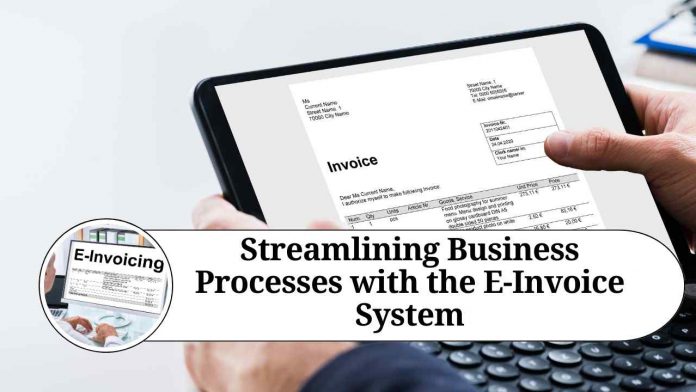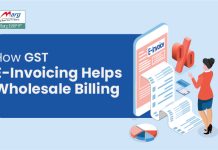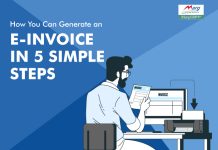Recent Updates on e-Invoicing:
10th May 2023
The Central Board of Indirect Taxes and Customs (CBIC) has announced the initiation of the 6th phase of e-invoicing to further the government’s aim of promoting a paperless Goods and Services Tax (GST) system. This measure is intended to reduce compliance expenses for businesses and enhance the efficiency of the GST system. Starting from August 1st, 2023, companies that have had an annual turnover exceeding ?5 crore since the fiscal year 2017-18 will be mandated to generate electronic invoices.
Introduction
In today’s digital age, businesses are constantly seeking innovative solutions to improve their efficiency and streamline their operations. One such technological advancement that has revolutionized the way companies manage their financial transactions is the e-invoice system. The e-invoice system replaces the traditional paper-based invoicing process with electronic invoices, bringing numerous benefits to businesses of all sizes. In this blog post, we will explore the advantages and functionalities of the e-invoice system and its potential impact on businesses.
What is the E-Invoice System?
The e-invoice system is a digital platform that allows businesses to create, transmit, and store invoices electronically. It eliminates the need for paper invoices, enabling companies to automate and digitize their invoicing processes. E-invoices are generated in a standardized electronic format, ensuring compatibility and seamless integration with other software systems, such as accounting and enterprise resource planning (ERP) systems.
Advantages of the E-Invoice System:
2.1. Cost and Time Efficiency: By adopting e-invoicing, businesses can significantly reduce the costs associated with printing, postage, and manual processing of invoices. Electronic invoices can be generated and delivered instantly, eliminating delays and speeding up the payment cycle. This efficiency translates into cost savings and improved cash flow management.
2.2. Enhanced Accuracy and Data Integrity: Manual data entry is prone to errors, leading to discrepancies and delays in invoice processing. The e-invoice system automates data entry, ensuring accuracy and consistency in invoice details. Additionally, electronic invoices are tamper-proof, as they contain digital signatures and authentication mechanisms, safeguarding the integrity of the data.
2.3. Streamlined Workflow and Faster Payments: E-invoices can be seamlessly integrated into the existing business systems, enabling automated workflows and eliminating manual intervention. The system can trigger payment reminders and notifications, reducing the chances of delayed payments. With faster and more streamlined processes, businesses can enhance their relationships with suppliers and customers.
2.4. Improved Compliance and Audit Trail: The e-invoice system provides a transparent and traceable audit trail, facilitating compliance with tax regulations and making audits more efficient. Digital invoices are stored securely and can be accessed easily for future reference. This ensures that businesses are compliant with legal requirements and simplifies the auditing process.
Implementation and Integration:
Implementing an e-invoice system requires careful planning and coordination with relevant stakeholders. It involves integrating the e-invoicing solution with existing accounting and ERP systems. Many e-invoice systems offer application programming interfaces (APIs) that facilitate seamless integration with other software applications. Additionally, businesses may need to educate their employees and trading partners about the new system and its benefits.
- E-Invoice System and Global Adoption: The adoption of e-invoice systems has gained significant traction worldwide. Many countries have mandated the use of electronic invoices to promote efficiency, transparency, and combat tax evasion. Businesses operating internationally must be aware of the e-invoice regulations in different jurisdictions to ensure compliance with local laws.
- Future Trends and Innovations: As technology continues to evolve, the e-invoice system is expected to undergo further advancements. Integration with artificial intelligence (AI) and machine learning (ML) capabilities can enhance the system’s ability to detect anomalies, identify patterns, and improve fraud detection. Additionally, the integration of blockchain technology can provide enhanced security and immutability to the e-invoice system.
Conclusion
The e-invoice system is transforming the way businesses manage their financial transactions. Its cost-effectiveness, accuracy, efficiency, and compliance benefits make it an attractive solution for organizations seeking to streamline their invoicing processes. By embracing e-invoicing, businesses can unlock new opportunities for growth, reduce administrative burdens, and optimize their financial operations in an increasingly digital world.
Read more useful content:
Frequently Asked Questions (FAQs)
Q1: What is an e-invoice system?
A1: An e-invoice system is a digital platform that enables businesses to create, transmit, and store invoices electronically. It replaces the traditional paper-based invoicing process with electronic invoices in a standardized format.
Q2: How does an e-invoice system work?
A2: The e-invoice system works by generating invoices in a digital format, typically using accounting or invoicing software. These electronic invoices are then securely transmitted to the recipient through various channels, such as email or a dedicated electronic data interchange (EDI). The recipient can access and process the invoice digitally, automating the payment and reconciliation processes.
Q3: What are the benefits of using an e-invoice system?
A3: Using an e-invoice system offers several benefits, including cost and time efficiency, enhanced accuracy and data integrity, streamlined workflow, faster payments, improved compliance, and a transparent audit trail. It also promotes environmental sustainability by reducing paper usage.
Q4: Is the e-invoice system secure?
A4: Yes, the e-invoice system ensures security through various measures. Electronic invoices are often equipped with digital signatures and authentication mechanisms, making them tamper-proof. Additionally, secure transmission channels and encryption techniques are used to protect the confidentiality of the invoice data.
Q5: Can an e-invoice system be integrated with existing software systems?
A5: Yes, most e-invoice systems offer integration capabilities with other software systems such as accounting, ERP, and inventory management software. This integration allows for seamless data exchange and automated workflows, improving operational efficiency.
Q6: Are there any legal requirements for using an e-invoice system?
A6: The legal requirements for using an e-invoice system may vary across jurisdictions. Many countries have specific regulations and standards in place for electronic invoicing. It is important for businesses to understand and comply with the e-invoice regulations applicable in their respective regions.
Q7: Does implementing an e-invoice system require technical expertise?
A7: While technical expertise can be beneficial during the implementation process, many e-invoice systems are designed to be user-friendly and require minimal technical knowledge. Service providers often offer support and training to assist businesses in adopting and utilizing the system effectively.
Q8: Can an e-invoice system be used for international transactions?
A8: Yes, e-invoice systems can be used for international transactions. However, businesses should be aware of the e-invoice regulations and compliance requirements specific to each country they operate in to ensure proper implementation and adherence to local laws.
Q9: What are the future trends in e-invoicing?
A9: The e-invoice system is expected to evolve with advancements in technology. Future trends may include the integration of artificial intelligence (AI) and machine learning (ML) for anomaly detection and fraud prevention. Additionally, the use of blockchain technology may enhance security and immutability in e-invoicing processes.
Q10: How can businesses get started with an e-invoice system?
A10: To get started with an e-invoice system, businesses can research and select a suitable e-invoice solution provider. They should consider factors such as features, compatibility with existing systems, security measures, and customer support. Once a provider is chosen, the implementation process can be initiated, which may involve system integration, employee training, and onboarding trading partners.




















